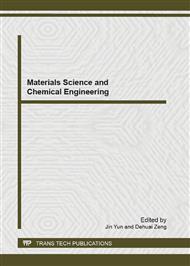p.578
p.584
p.590
p.596
p.606
p.612
p.616
p.620
p.624
Influence of Deposition Temperature on the Structural and Optoelectronic Properties of CdZnS Thin Films
Abstract:
CdZnS thinfims have been prepared on mineral glass substrate by spray pyrolysis method at different deposition temperature using the optimized coating parameters. The XRD profile of the films confirms hexagonal wurtizite structure with preferred orientation along the (101) pane. The different crystallographic parameters viz., lattice constant, c/a ratio, mean grain size, number of reflections per unit area, lattice strain, dislocation density, texture coefficient and standard deviation have been calculated from the experimentally observed XRD data and the effect of deposition temperature on these parameters have been elaborately discussed. The maximum optical transmittance of 84.5% (at λ= 650 nm ) has been observed for the CdZnS thin film spray deposited at the temperature 450 °C. The direct band gap energy calculated from the transmittance measurements lies between 2.82 eV and 3.4 eV. The electrical resistivity has been found to be low with the value 50 x 103 Ω - cm for the film deposited at the temperature 450 °C. The SEM micrographs of the films show uniform surface pattern associated with large accumulation of fine grains. The grain size estimated from the SEM analysis lies between 100 nm and 350 nm.
Info:
Periodical:
Pages:
606-611
Citation:
Online since:
May 2013
Price:
Сopyright:
© 2013 Trans Tech Publications Ltd. All Rights Reserved
Share:
Citation:


